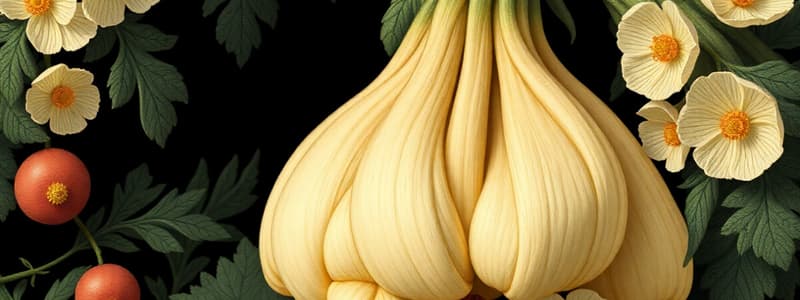Podcast
Questions and Answers
Which of the following is NOT a characteristic use of fixed oil from fennel?
Which of the following is NOT a characteristic use of fixed oil from fennel?
- Laxative (correct)
- Antispasmodic
- Diuretic
- Expectorant
What is one of the recent uses of fennel highlighted in the content?
What is one of the recent uses of fennel highlighted in the content?
- Calming effects
- Proliferation inhibition (correct)
- Anti-inflammatory activity
- Pain relief
Which property of fennel oil contributes to liver regeneration?
Which property of fennel oil contributes to liver regeneration?
- Analgesic
- Sedative
- Antioxidant (correct)
- Antimicrobial
What effect does fennel oil have on appetite?
What effect does fennel oil have on appetite?
Which of the following statements about fennel oil's antibacterial properties is true?
Which of the following statements about fennel oil's antibacterial properties is true?
What characteristic distinguishes umbelliferous fruits?
What characteristic distinguishes umbelliferous fruits?
Which of the following pairs of fruits are often confused due to their similar names?
Which of the following pairs of fruits are often confused due to their similar names?
Which fruit is NOT considered umbelliferous?
Which fruit is NOT considered umbelliferous?
Which umbelliferous fruit is known for its potentially toxic properties?
Which umbelliferous fruit is known for its potentially toxic properties?
What is a common feature of umbelliferous fruits regarding their structure?
What is a common feature of umbelliferous fruits regarding their structure?
Flashcards are hidden until you start studying
Study Notes
Umbelliferous Fruits
- Schizocarpic - they split into two single-seeded fruits called cremocarps
- Fixed oil and protein are the primary components
Fennel
- Anethole and Fenchone are key constituents
- Pharmacological effects include antispasmodic, carminative, diuretic, expectorant, lactation stimulant, flavoring agent, liver regeneration stimulant, antibacterial, and antioxidant properties
- Recent uses include anti-Candida activity, cell cycle arrest and apoptosis induction for potential anti-cancer treatment, and appetite enhancement
Anise
- Active constituents include volatile oil, primarily trans-anethole and also lipids rich in fatty acids like palmitic and oleic acids
- Microscopic features include separated mericarps, ovoid shape with 5 prominent primary ridges, no hairs, no vittae, crenate-beade appearance, and inconspicuous vittae
Hemlock
- Microscopic features include deeply grooved endosperm surrounded by an alkaloid-containing layer, campylospermous seed, no clear vittae, no parquetry layer, and an endocarp made of thickened and lignified U-shaped cells
- Uses include antispasmodic and anticonvulsant properties
- Constituents include piperidine alkaloids such as coniine, γ-coniceine, conhydrine, pseudoconhydrine, methyl coniine, and ethyl-piperidine
Coriander
- Constituents include volatile oils, mainly linalool
- Traditional uses include antispasmodic properties
- Current uses include hypoglycemic properties
Studying That Suits You
Use AI to generate personalized quizzes and flashcards to suit your learning preferences.
